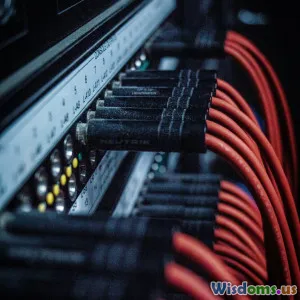
Building Resilient Networks Against Emerging Security Threats
14 min read Explore proactive strategies for building resilient networks to counter emerging cybersecurity threats and safeguard digital infrastructure. (0 Reviews)
Building Resilient Networks Against Emerging Security Threats
When working with the intricate fabric of today’s digital infrastructure, one reality stands out: cybersecurity threats are no longer confined to static perimeters or predictable attack vectors. Enterprises, regardless of size, are constantly in a tug-of-war with adversaries whose tactics evolve and adapt as quickly—if not faster—than our defenses. Building robust, resilient networks is not just a matter of patching the latest software vulnerability; it’s about preparing organizations to withstand, recover from, and adapt to unknown and emerging threats.
Understanding the Shifting Threat Landscape

The digital revolution has sparked an explosion of connected devices and cloud-based resources. While this shift enables greater flexibility and productivity, it also increases the attack surface for malicious actors. Recent years have seen an upswing in ransomware attacks, supply-chain intrusions, DDoS assaults, and sophisticated phishing campaigns—all with the potential to cripple even the most prepared organizations.
For example, the rapid global shift to remote work since 2020 brought a dramatic rise in attacks exploiting Remote Desktop Protocol (RDP), VPN vulnerabilities, and unsecured IoT devices. Meanwhile, sophisticated attackers target critical infrastructure: in 2021, the Colonial Pipeline ransomware incident in the US led to serious fuel shortages and stark reminders of how cyberattacks can have real-world consequences.
Key insights:
- Complexity breeds risk: More connected services and devices mean greater opportunity for attackers.
- Adversaries collaborate: Cybercriminal groups share techniques, tools, and data, making defense more challenging.
- Regulatory and reputational stakes are higher: GDPR, CCPA, and similar laws intensify not only penalties but public scrutiny for breaches.
Designing Networks for Adaptability and Strength

A resilient network starts with thoughtful architecture that anticipates failure—whether from cyberattack, human error, or hardware malfunction. Traditional “castle-and-moat” approaches, based on clear internal and external boundaries, have grown obsolete. Today’s resilient networks employ principles such as defense-in-depth, segmentation, and zero trust.
Defense-in-depth, for instance, is a classically military strategy: placing multiple defensive layers so that even if one fails, the adversary faces more hurdles. In practical terms, this might mean using firewalls, intrusion prevention systems, anomaly detectors, and robust encryption throughout every network segment—not just at entry points.
Case Study:
The retail giant Target’s infamous 2013 breach began when attackers exploited third-party HVAC credentials. Had the internal network segmentation been stricter, lateral movement would have been harder, potentially limiting exfiltration of over 40 million credit card numbers. This event pushed many organizations to re-examine flat, overly trusting internal networks.
Tips for network adaptability:
- Micro-segmentation: Allow only necessary communications within and between segments—for example, finance systems never see R&D devices.
- Zero-trust principles: Always authenticate and verify access, regardless of source location.
- Automated threat containment: Employ systems that can disconnect affected segments upon detecting anomalies, minimizing blast radius.
Harnessing Threat Intelligence for Proactive Defense

Static, signature-based security tools alone are outmatched by clever, elusive adversaries. Instead, organizations need a constant feed of fresh, actionable threat intelligence that enables them to anticipate attacker moves.
Threat intelligence goes beyond blocking known bad IPs—it correlates signals from threat feeds, dark web forums, honeypots, and global security firms to pierce the “fog of war.” For example, before the NotPetya ransomware outbreak in 2017, intelligence vendors observed actors weaponizing legitimate accounting software updates across Eastern Europe. Clients with timely, customized feeds were able to shore up protocols before the attack’s full impact.
Actionable advice:
- Integrate external and internal intelligence: Use threat-hunting platforms that ingest multiple sources: open-source, subscription feeds, user behavior analytics, and incident response data.
- Cultivate cross-industry partnerships: Join ISACs (Information Sharing and Analysis Centers) relevant to your sector, such as Energy-ISAC or FS-ISAC (for finance), to get early warnings.
- Automate alerts: Employ SIEM (Security Information and Event Management) and SOAR (Security Orchestration, Automation, and Response) tools that surface and prioritize relevant intelligence.
Evolving Identity and Access Management (IAM)

Identity is the new perimeter. As remote and hybrid work become the norm, ensuring only verified users and devices access resources is critical. Breaches such as those involving Okta or Microsoft 365 have proven even small holes in IAM practices can be catastrophic, given widespread third-party and BYOD (bring your own device) integrations.
Modern IAM strategies:
- Multi-Factor Authentication (MFA): MFA thwarts many credential-based attacks. When combined with adaptive policies (e.g., requiring additional checks for high-risk logins), organizations further raise the bar against attackers.
- Federated identity / SSO: Consolidate access control and monitoring by centralizing through secure Single Sign-On (SSO). Implement least-privilege principles—ensuring users (including contractors) only access what they absolutely need.
- Continuous authentication: Leverage behavioral biometrics and real-time analytics to re-validate identities in the background if risky actions or locations are detected.
Example:
A large European pharmaceutical firm was targeted by attackers using phishing to steal low-level credentials. Because IAM logged excessive access attempts and deviation from regular work hours, the breach was contained to a demo server. Continuous monitoring and least-privilege rules ensured sensitive clinical trial data remained untouched.
Building in Robust Endpoint and Cloud Security

With the perimeter dissolving, the focus shifts to protecting every node—workstations, mobile devices, and cloud workloads alike. Poorly secured endpoints are often the initial vector for attack and lateral movement.
Endpoints:
- EDR/XDR platforms: Endpoint Detection and Response, and its evolution to Extended Detection and Response, deliver real-time visibility into device behavior, quickly shutting down malware, ransomware, and suspicious scripts. These platforms also simplify compliance.
- Automated patch management: With attackers exploiting vulnerabilities sometimes hours after disclosure (see: ProxyLogon or Log4j vulnerabilities), automated or zero-touch patching is a must.
- Device posture assessment: Enforce conditional access—restricting network access to devices that meet up-to-date security baselines.
Cloud security:
Hybrid environments introduce additional risks:
- Shared responsibility: Understand the difference between your and your cloud provider’s duties—misconfiguration is a top risk, as evidenced by repeated accidental data exposures on AWS S3 buckets.
- Identity-centric controls: Extend IAM, DLP (Data Loss Prevention), and strong encryption to cloud workloads. Enforce least-privilege even across APIs and container ecosystems.
- Continuous monitoring: Use cloud-native security solutions (such as AWS GuardDuty, Azure Security Center) for visibility and automated alerting on suspicious behavior.
Deploying Advanced Detection and Automated Response

Timely detection and response can mean the difference between a minor incident and a crippling breach. Modern Security Operations Centers (SOCs) use innovative methods to improve their speed, accuracy, and resilience.
- Behavioral analytics: Machine learning distinguishes between benign and malicious anomalies—such as detecting an admin suddenly accessing a mass of sensitive files outside work hours.
- SOAR Integration: Security Orchestration, Automation, and Response automates first-level triage, isolating threatened assets, collecting forensic data, and running playbooks without human delay.
- Deception technologies: Deploying honeypots and canary tokens within the network can catch sophisticated attackers while diverting them from valued assets.
Case Study:
A major North American manufacturer experienced repeated insider attempts to access confidential blueprints. By deploying canary files and monitoring unusual admin script deployments, security teams identified and shut down the breach before data exfiltration. SOAR workflows alerted stakeholders instantly and preserved logs for law enforcement.
Nurturing People and Processes to Support Technology

Technology, no matter how sophisticated, crumbles if not underpinned by knowledgeable users and clearly defined processes. While investing in next-gen firewalls and XDR solutions matters, attackers still find success exploiting social engineering and insider error.
Key elements:
- Security awareness training: Regular, realistic simulations—phishing emails, USB drop exercises, and social engineering drills—improve workforce vigilance.
- Incident response planning: Regularly test and update IR plans through red team/blue team exercises and tabletop drills. When teams know roles and steps during a crisis, recovery is faster and reputational damage minimized.
- Security champions: Foster a security-first culture by enrolling champions in each department—these advocates bridge gaps between IT and business units.
Example:
A UK-based healthcare organization routinely runs department-specific security drills. When a real phishing campaign targeted clinicians with COVID-19 themed fake emails, response times were swift and no credentials were lost, thanks to rapid reporting and educated skepticism.
Future-Proofing With Adaptive Technologies

Defenders can take heart: as adversaries innovate, technology continues to level the playing field. Promising developments are empowering organizations to become more adaptive and proactive.
Key emerging trends:
- Artificial Intelligence & Machine Learning: AI engines, fed by massive threat data sets, can flag abnormal behavior within seconds, often preemptively stalling attacks. SentinelOne, Darktrace, CrowdStrike—leaders in this realm—offer autonomous protection models that react faster than any human team could.
- Fault-tolerant architectures: Self-healing networks automatically re-route traffic around attacked or failed nodes, using principles similar to those pioneered by disaster recovery experts in the financial sector.
- Quantum cyber-resilience: With quantum computing on the horizon, forward-looking organizations experiment with quantum-resistant cryptography. Google, for instance, has begun incorporating post-quantum algorithms in some services to future-proof customer security.
Comparison: Traditional security controls often react painfully slow to novel threats. Adaptive, AI-driven networks, equipped with predictive analytics and automated containment, can close gaps in real time—a necessary edge against high-velocity, machine-paced attacks.
The battle to protect digital assets is not static and no silver-bullet solution exists. However, building resilient networks is ultimately an investment in adaptability, awareness, and collaboration—across technology, people, and process. As attackers refine their tactics, so too must defenders refine and blend their approaches, ready not only to detect and repel threats but to recover and emerge stronger. By integrating layered security, proactive intelligence, rapid response strategies, and a culture of vigilance, organizations position themselves not just to survive the next wave of attacks—but to thrive amid uncertainty.
Rate the Post
User Reviews
Popular Posts


















